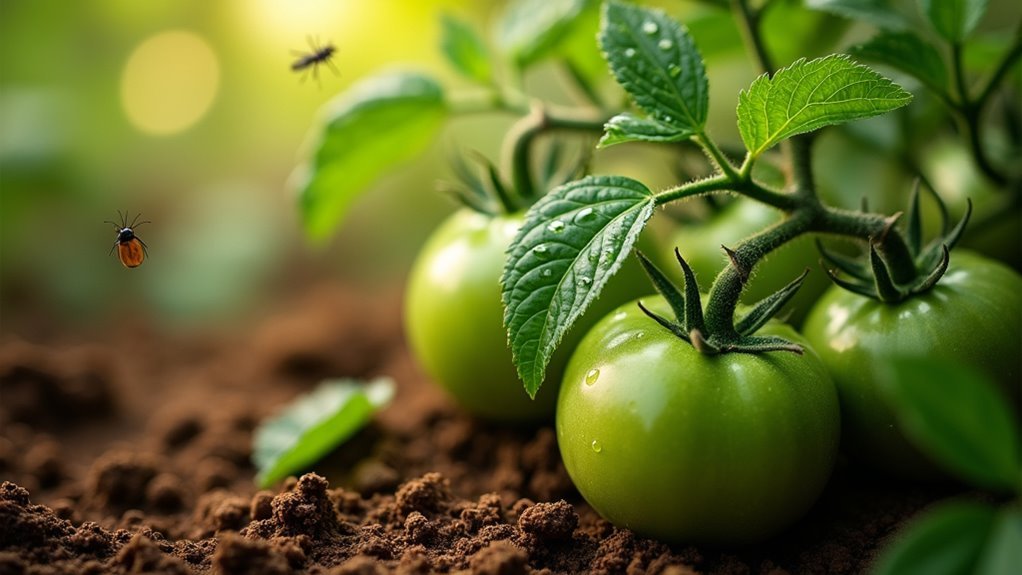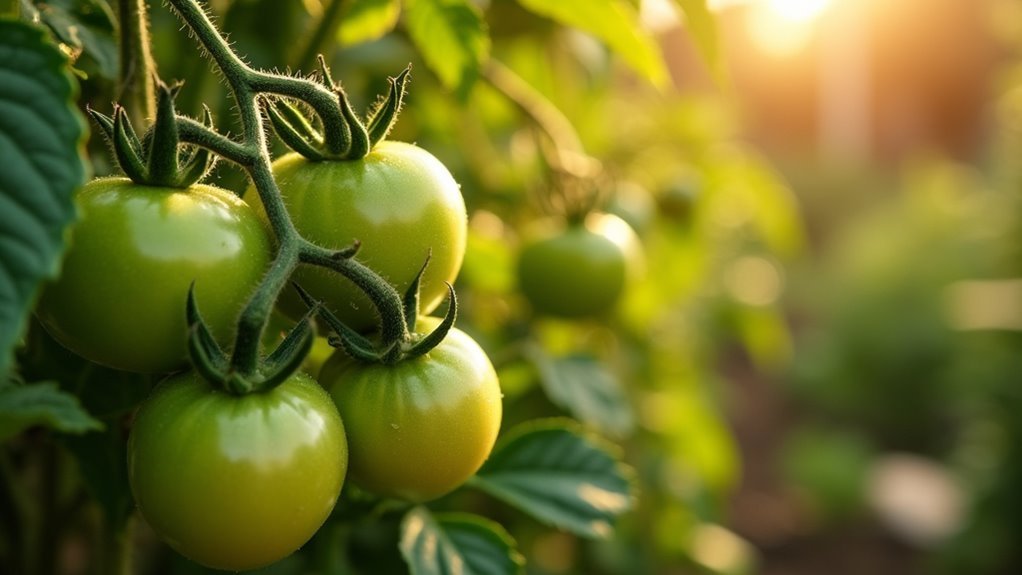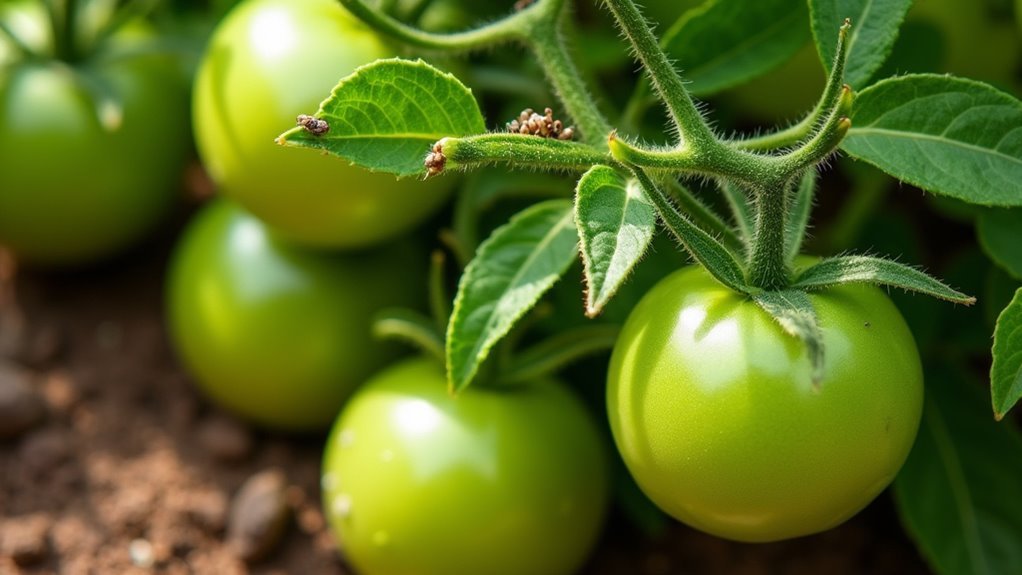You’ll stop tomato pests effectively with a proven neem oil formula: mix 2 tablespoons of cold-pressed neem oil with 1 gallon of water and 1 teaspoon of mild dish soap as an emulsifier. This combination targets aphids, whiteflies, spider mites, and thrips while preserving beneficial insects. Apply every 7-14 days during early morning or late evening, thoroughly coating both leaf tops and undersides. For severe infestations, increase to 3-4 tablespoons per gallon. Perfect timing and application techniques maximize your results.
Understanding Neem Oil’s Pest-Fighting Properties

When you’re battling tomato pests in your garden, neem oil stands out as one of nature’s most effective weapons. The azadirachtin content serves as the primary active compound that disrupts pest hormonal systems, preventing feeding and reproduction cycles. This powerful pest control solution targets common threats like aphids, whiteflies, and spider mites without harming beneficial insects in your garden ecosystem.
Beyond insect management, applying neem oil provides fungicidal protection against diseases like powdery mildew and early blight that can devastate tomato plants. The active compounds work systematically to create an inhospitable environment for pests while maintaining safety for pollinators and predatory insects.
This dual-action approach makes neem oil perfect for organic gardening practices, delivering thorough protection through natural mechanisms.
Essential Ingredients for Effective Neem Oil Formulas
You’ll need to understand neem oil’s core active compounds to create formulas that effectively combat tomato pests.
The key lies in azadirachtin, the primary insecticidal compound found in cold-pressed neem oil, which disrupts pest feeding and reproductive cycles.
Getting your mixing ratios right guarantees you’ll achieve maximum potency without harming your plants—typically 1-2 tablespoons per gallon provides the perfect balance for most tomato pest issues.
Core Active Compounds
Azadirachtin stands as neem oil’s most potent weapon against tomato pests, disrupting their hormonal systems to halt growth and reproduction cycles. This primary compound targets destructive insects while preserving beneficial organisms in your garden ecosystem.
You’ll find nimbin as another essential active ingredient that combats fungal and bacterial infections threatening your tomato plants.
Cold-pressed organic neem formulations deliver the highest concentration of these protective compounds. When selecting pest and disease control products, prioritize those using unrefined extraction methods to maximize potency.
Quality emulsifiers enhance these active ingredients’ effectiveness by improving water dispersion and plant surface adhesion. Together, azadirachtin and supporting compounds create all-encompassing protection against aphids, spider mites, and fungal diseases like powdery mildew.
Proper Mixing Ratios
Although neem oil’s active compounds provide powerful pest control benefits, improper dilution ratios can reduce effectiveness or damage your tomato plants.
When you apply neem oil, use 1-2 tablespoons of cold-pressed quality neem per gallon of water for ideal results. Don’t use too much neem oil, as concentrated solutions can burn foliage.
To properly blend oil and water, add several drops of dish soap before mixing. This prevents separation and guarantees even distribution throughout your solution.
Always shake vigorously before application to maintain proper emulsification.
High-quality neem oil products work best as a preventative measure when applied every 7-14 days. Using neem oil consistently at correct ratios provides effective pest management without harming your plants.
Proven Neem Oil Recipes That Stop Tomato Pests

You’ll need reliable recipes that consistently eliminate tomato pests without harming your plants.
A basic spray recipe forms the foundation of effective neem oil treatment, while understanding proper concentration formulas guarantees you’re targeting specific pest problems.
These proven mixtures have helped countless gardeners protect their tomato crops from destructive insects and diseases.
Basic Spray Recipe
One simple recipe transforms neem oil into a powerful weapon against tomato pests.
Mix 1-2 tablespoons of cold-pressed neem oil with 1 gallon of water, adding several drops of dish soap to create proper emulsification. Load this mixture into your spray bottle and thoroughly coat all plant surfaces.
You’ll want to target the undersides of the leaves where spider mites and aphids typically hide.
Apply the neem oil spray during early morning or late evening hours to prevent leaf burn and protect beneficial insects from harm.
For effective pest control, reapply your neem oil spray every 7-14 days or immediately after heavy rainfall washes away the protective coating.
This formula doubles as a fungicide, preventing common tomato diseases.
Treatment Concentration Formula
When dealing with severe infestations, you’ll need a stronger concentration than the basic spray recipe. Neem oil works best when you increase the ratio to 3-4 tablespoons of neem oil concentrate per oil to 1 gallon of water, maintaining 2 teaspoons of castile soap for proper emulsification.
Apply this intensified solution every 5-7 days until pest populations decline. The neem seeds of the neem tree contain azadirachtin, which disrupts pest life cycles effectively.
For powdery mildew prevention, create a preventative mixture using 2 teaspoons per quart instead of the standard amount.
Don’t forget soil treatment applications—use the concentrated formula for neem oil on tomato root zones to target soil-dwelling pests like nematodes more aggressively.
Step-by-Step Application Methods for Maximum Results
Since proper application technique determines neem oil’s effectiveness against tomato pests, you’ll need to start by creating the right concentration for your specific pest problem.
Apply the neem oil solution using a clean gallon sprayer early morning or late evening to avoid leaf burn and protect beneficial insects. Focus on achieving maximum coverage by thoroughly coating both leaf tops and undersides where pests hide.
For thorough tomato protection, combine foliar spraying with soil soaking methods. Mix 2-3 cups of your neem seed oil solution around each plant’s base every 2-3 weeks to target root-dwelling pests like nematodes.
Reapply foliar treatments every 7 to 14 days or after rainfall. Always wear gloves and protective eyewear during application for safety.
Timing and Frequency for Optimal Pest Control

Timing your neem oil applications strategically means the difference between successful pest control and wasted effort on your tomato plants.
Strategic timing transforms neem oil from ineffective spray into powerful pest control weapon for your tomato garden.
You’ll achieve ideal results when you apply every 7 to 14 days, as neem oil’s gradual action requires consistent scheduling. Since neem oil is cold-pressed and potent, spray during early morning or late evening to prevent leaf burn while maximizing absorption.
Mix 1 to 2 tablespoons with a quart of water plus dish soap for effective coverage.
You’ll need to reapply after heavy rainfall or overhead watering since moisture washes away the protective coating. Time your applications just before peak pest activity periods to prevent pests from establishing colonies.
This strategic approach guarantees continuous protection while allowing the oil’s natural compounds to work effectively against harmful insects.
Troubleshooting Common Formula Mistakes
Several mistakes can sabotage your neem oil mixture’s effectiveness, turning what should be powerful pest control into a frustrating waste of time and resources. When you don’t correctly dilute neem oil, you’ll either waste product or cause leaf burn that damages your tomatoes.
| Common Mistake | Consequence |
|---|---|
| Wrong concentration ratios | Ineffective pest control or foliage damage |
| Skipping emulsifier addition | Uneven distribution, poor coverage |
| Midday application timing | Severe leaf burn from sun exposure |
You must apply the neem oil during cooler hours to protect beneficial insects like bees. Incorporating neem cake or other additives won’t improve basic formulations. While neem application requires precision, avoiding these errors guarantees successful pest management without harming your plants.
Frequently Asked Questions
What Is the Mixture for Neem Oil on Tomato Plants?
You’ll mix 1-2 tablespoons of cold-pressed neem oil with 1 gallon of water, adding several drops of dish soap to help emulsify the oil and guarantee it coats your tomato plant surfaces evenly.
What Is the Best Thing to Keep Bugs off Tomato Plants?
You’ll find neem oil works best for keeping bugs off tomato plants. Mix 1-2 tablespoons with one gallon of water plus dish soap, then spray every 7-14 days targeting leaf undersides.
What Is the Mixing Ratio for Neem Oil?
You’ll want to mix 1-2 tablespoons of neem oil per gallon of water. Add a few drops of dish soap as an emulsifier to help the oil blend properly with water.
How Do You Dilute Neem Oil for Pest Control?
You’ll dilute neem oil by mixing 1-2 tablespoons of cold-pressed neem oil with 1 gallon of water. Add a few drops of dish soap to help the oil emulsify and distribute evenly throughout the solution.
In Summary
You’ll achieve the best tomato pest control by mixing 2 tablespoons of pure neem oil with 1 teaspoon of mild liquid soap per gallon of water. Apply this formula every 7-10 days during early morning or evening hours, ensuring you’re coating all plant surfaces thoroughly. Don’t skip the undersides of leaves where pests hide. With consistent application and proper timing, you’ll protect your tomatoes from aphids, whiteflies, and hornworms naturally.





Leave a Reply